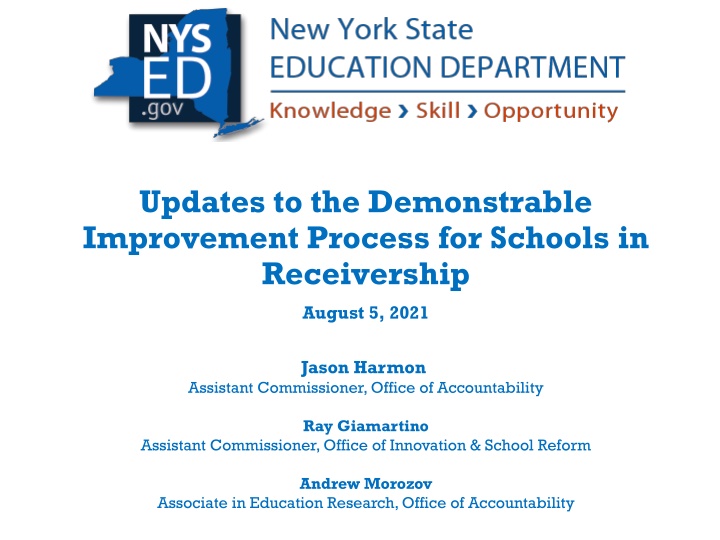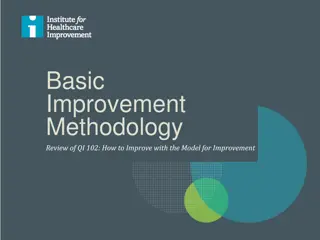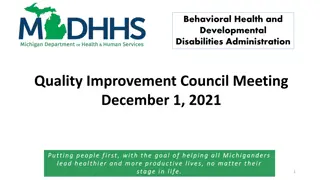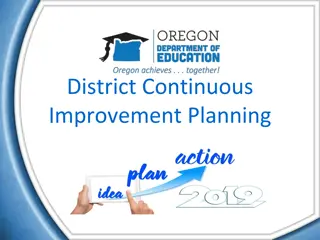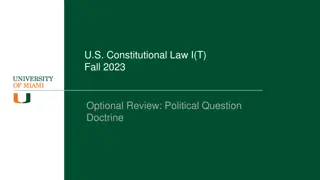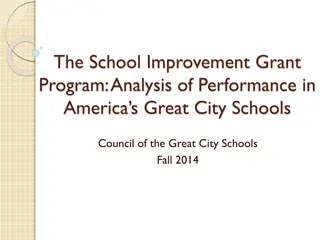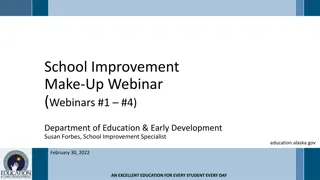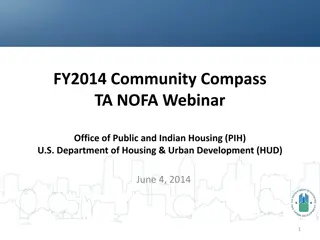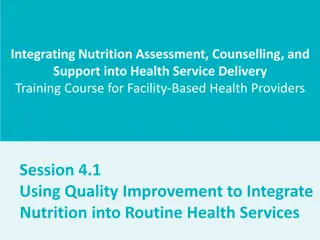Updates to Demonstrable Improvement Process for Schools in Receivership
Explore the recent updates to the Demonstrable Improvement Process for schools in receivership, including changes to the 2020-21 and 2021-22 DI processes, OISR-OA office hours, next steps, and resources. Find out about the reporting of 2020-21 school year results, waivers, and what not to expect in the fall of 2021.
Download Presentation

Please find below an Image/Link to download the presentation.
The content on the website is provided AS IS for your information and personal use only. It may not be sold, licensed, or shared on other websites without obtaining consent from the author.If you encounter any issues during the download, it is possible that the publisher has removed the file from their server.
You are allowed to download the files provided on this website for personal or commercial use, subject to the condition that they are used lawfully. All files are the property of their respective owners.
The content on the website is provided AS IS for your information and personal use only. It may not be sold, licensed, or shared on other websites without obtaining consent from the author.
E N D
Presentation Transcript
Updates to the Demonstrable Improvement Process for Schools in Receivership August 5, 2021 Jason Harmon Assistant Commissioner, Office of Accountability Ray Giamartino Assistant Commissioner, Office of Innovation & School Reform Andrew Morozov Associate in Education Research, Office of Accountability
Agenda 1. Introduction: Dr. Ray Giamartino, Jr., Assistant Commissioner (Office of Innovation and School Reform) 2. Updates to the 2020-21 DI Process 3. Updates to the 2021-22 DI Process 4. OISR-OA Office Hours 5. Next Steps 6. Resources and Questions 2
1. Introduction: Dr. Ray Giamartino, Jr. Assistant Commissioner Office of Innovation and School Reform (OISR)
No DI determinations for 2020-21 The Department will not use the 2020-21 school year results to make Demonstrable Improvement (DI) determinations for schools in Receivership, place any schools in Independent Receivership, or remove the designation of any school as Struggling. All schools identified as Struggling for the 2020-21 school year shall remain so identified for the 2021-22 school year. All schools that are operated under a school district Superintendent Receiver in the 2020-21 school year shall continue to operate under a school district Superintendent Receiver for the 2021-22 school year. See the June 22, 2021 Memo: http://www.nysed.gov/common/nysed/files/accountability/memo/accountability-waiver- announcement-memo-062221.pdf 5
Reporting of 2020-21 school year results for DI indicators The Department is waiving the requirement for districts to submit the 2020-21 school year results for their DI indicators to the Office of Accountability (OA). This waiver does not apply to any data that districts must submit to the Student Information Repository System (SIRS) in accordance with annual reporting requirements as directed by the Office of Information and Reporting Services (IRS). See the June 22, 2021 Memo: http://www.nysed.gov/common/nysed/files/accountability/memo/accountability-waiver- announcement-memo-062221.pdf 6
What Not to Expect in the Fall of 2021 There will be no preliminary data review and appeal process. The Department will not release preliminary DI results to the districts and CETs. The Department will not compute the 2020-21 DI Indices for any schools. The Commissioner will not make DI determinations in the Fall of 2021. The 2020-21 school year results will not be released on the Receivership Dashboard. 7
Changes to 2020-21 School Year Reporting Due to changes in the administration of state assessments the Department will not compute any DI indicators using the 2020-21 school year results. Districts will not submit results for indicators #2 (CS), #94 (ELT), #5 (School Safety), #6-8 (DTSDE Tenets), and Local indicators via email.* Districts will not submit August graduates via the IRS Data Exchange (IDEx).* Districts must submit the data for their indicators via SIRS (similar to 2019-20). Data must be submitted via SIRS following guidance and timelines from the IRS. * For 2019-20, districts could opt into voluntary reporting of outcomes for these indicators to the Department. 8
Updates to the 2021-22 DI Process Topics: Considerations for Making DI Determinations Carryover of the Indicators and Annual Progress Targets. Alternative indicators for 2021-22. Assigning additional Level 1 indicators. Updates to indicators: Indicator #4 (Suspension Rate) Indicator #5 (School Safety/SVI) Indicator #6 (DTSDE Tenet 6: Family and Community Engagement) Extension for Public Hearing 10
Schools in Superintendent Receivership Cohort 1: Schools that were in Receivership status for the 2017-18 school year and were re- identified in the 2018-19 school year (N=14). Cohort 2: Schools that were newly identified in the 2018-19 school year (N=24). 11
How a School Exits Receivership Cohort 1 and Cohort 2 Schools: Schools will be removed from Receivership at the end of the school year in which the school is not identified as a Comprehensive Support and Improvement (CSI) School. The first opportunity for removal will be June 2023 if a school made CSI Progress based on 2018-19 and 2021-22 school year results. The next opportunity for removal will be June 2024 if a school is not re-identified as CSI based on 2022-23 school year results. Making DI does not determine whether a school is placed into or removed from Receivership. Making DI determines whether a school continues under a Superintendent Receiver or is placed in Independent Receivership. 12
Considerations for Making DI Determinations The Department is assessing the timelines for making accountability and DI determinations and the viability of making determinations using the 2021-22 school year results. The Department is considering a waiver request to USDE to use 2021-22 school year results to reestablish robust and stable baselines for measuring school and district performance on accountability indicators instead of making determinations. Unless the Department secures a waiver from USDE, districts should expect that the Department will make DI determinations using 2021-22 school year results. The Department will communicate additional details as soon as more information is available. 13
Carryover of Indicators and Progress Targets The indicators that are currently assigned to the schools for 2020-21 will carry over to 2021-22. Exception: Alternative indicators will be provided if restructuring results in a school having fewer than the required minimum number of Level 1 or Level 2 indicators. The Annual Progress Targets will carry over. The 2020-21 Targets will become the 2021-22 Targets. The 2021-22 Targets will become the 2022-23 Targets. The Department does not currently intend to compute new Targets for existing DI indicators for the 2021-22 and 2022- 23 school years. 14
Alternative Indicators for 2021-22 Schools serving either Elementary-Middle (EM) or High School (HS) grade levels must have a minimum of five Level 1 and five Level 2 DI indicators. Schools serving both EM and HS grades must have a minimum of seven Level 1 and seven Level 2 indicators. The Department will not provide alternative indicators for the 2021-22 school year, except when necessary due to school restructuring. If restructuring results in a school having fewer than the required minimum number of Level 1 or Level 2 indicators, then the Department will provide alternative indicators. The selection of alternative indicators by the district must be in consultation with the school Community Engagement Team (CET). Alternative indicators can be Level 1 or Level 2 indicators selected from a list provided by the Department, or Local indicators proposed by the school. 15
Assigning Additional Level 1 Indicators The Department will not assign additional Level 1 indicators for the 2021-22 school year. If a Level 1 indicator result for the 2021-22 school year falls below the 2021-22 school year state baseline, that indicator may be assigned to the school as an additional Level 1 indicator for the 2022-23 school year. 16
Indicator #4 (Student Suspension Rate) As part of its ESSA plan, the Department is developing an out-of-school suspension measure. This information will be provided to schools at a later date. No change from 2020-21: Indicator #4 (Student Suspension Rate) will not be used for the 2021-22 school year. 17
Indicator #5 (School Safety/SVI) Change to the calculation methodology from 2020-21*: Remove the weighting of incidents Use a total of only the four most serious violent categories (homicide, felony assault, felony sexual offense, and weapons use/possession) Use a ratio of the sum of the four violent incident categories per 100 students SVI = (sum of incidents in 4 serious categories)/enrollment x 100 The Department will provide revised Progress Targets for 2021-22 and 2022-23 for the School Safety indicator in a separate communication. * See the July 22, 2021 Memo: http://www.p12.nysed.gov/sss/documents/SSEC21- 22memoFinal7.22.21.pdf. See also the 2021-22 SSEC Reporting Form: http://www.p12.nysed.gov/sss/ssae/schoolsafety/vadir/2021- 22SSECFormsInstructionsandGuidance.html 18
Indicator #6 (DTSDE Tenet 6: Family and Community Engagement) To simplify the reporting process for the DTSDE Tenet 6 indicator, the Department will provide a new reporting template in a separate communication in the summer of 2022. 19
Extension for Public Hearing Commissioner's Regulations 100.19 requires Receivership Schools to hold a public hearing to discuss the performance of the school within 30 calendar days of the first day of student attendance. Due to the pandemic, the Department is extending this timeline to December 1, 2021. The public hearing may be conducted virtually or in-person. Please inform your CET members. 20
WWII Analogy Are we asking the right questions and using the right evidence? 22
OISR-OA Office Hours: Goals An opportunity to reflect upon the 2020-21 data and anticipated impact 2021-22 school year results. Identify pressing concerns and potential blind spots related to key indicators and brainstorm a path forward. Focus on strategies going forward for addressing knowledge gaps in critical areas (e.g., participation rates, learning loss, absenteeism, SEL, equity). 23
OISR-OA Office Hours: Overview The Department is providing an opportunity to discuss data-driven improvement strategies for your school(s) in Receivership that focus on key DI indicators. Participation is voluntary and depends upon your district s areas of interest. Districts will receive an email invitation to sign up for virtual Office Hours . Interested districts will be asked to identify two to three DI indicators to discuss. 24
OISR-OA Office Hours: Guiding Questions In relation to your chosen DI indicators, be ready to discuss: During the 2020-21 academic year, identify student- specific performance, behavior and attendance data by grade-level and subgroup that informed building- and grade-level instructional and professional learning decisions that are consistent with the evidence required to show: Measurable student progress and growth at each administration interval on the local assessment. Increased average daily attendance. Reduced rates of behavioral incidents. How will summer 2021 data inform planning and practices for the 2021-22 school year? 25
OISR-OA Office Hours: Guiding Questions In relation to your chosen DI indicators, be ready to discuss: (continued) The tiered interventions and supports provided to the most at-risk students during instruction and testing. Note explicit district-level supports provided. How typically available data used for DI determinations (e.g., State assessments) will be reintegrated into existing data analysis for progress monitoring. The ways in which NYSED can support your district's use and application of data moving forward. 26
2020-21 Reporting Districts must submit the data for their SIRS-based indicators (similar to 2019-20). Data must be submitted via SIRS following guidance and timelines from IRS. Districts will not submit to OA the 2020-21 school year results for rubric-based indicators #2 (CS), #94 (ELT), #5 (School Safety), #6-8 (DTSDE Tenets), Local indicators, or August graduates via the IRS Data Exchange (IDEx). * Please refer to the Deadlines for Verification and Certification of 2020-21 School Year Data in SIRS. 28
Forthcoming Communications August 9th: Following the Webinar, on or around August 9th districts will receive a memo with a list of currently assigned indicators for Receivership schools that will reflect the carryover of Progress Targets. In the same email communication, districts will also receive an invitation to the virtual OISR-OA 'Office Hours' conversations. August 16th: Districts opt into 'Office Hours' with proposed indicators they would like to prioritize for the discussion. Later this fall the Department will contact districts regarding the selection of alternative indicators for 2021-22, where applicable, due to school restructuring or data availability considerations. 29
Resources Office of Accountability Receivership Webpage: http://www.nysed.gov/accountability/school-receivership- demonstrable-improvement-indicators Office of Innovation and School Reform: http://www.p12.nysed.gov/oisr/ FAQ Office of Information and Reporting Services (IRS): http://www.nysed.gov/information-reporting-services SIRS Deadlines for Verification and Certification of 2020-21 School Year Data in SIRS Data Help Center: https://datasupport.nysed.gov/hc/en-us 31
Questions? DI indicators and reporting: accountinfo@nysed.gov Support for Receivership schools: OISR@nysed.gov Annual data reporting in SIRS: datasupport@nysed.gov 32
